Even among the crowds of new planets discovered in the last decade, some may be surprised. The latest example was actually the second detection of the Kepler Space Telescope, which is not certain at the time. Finally verified, its curiosity orbit can teach us something about the formation of star systems. Mostly they come across in pairs, but since the planets are difficult to identify in this situation, we know a few “tattoo planets” comparable to the two suns. Triple star systems are very rare, so inevitably there are only a handful of planets. Where we do, it is usually found when one is near orbit far from the other two, such as Proxima Centauri.
The light from KOI-5 in 2009 aroused excitement when Kepler’s recording was very new. However, the intervention of the stars of the system as a possible world naming has created KOI-5Ab, which is a big challenge. Dr David Ciardi of NASA’s Exoplanet Science Institute said in a statement, “The pick was easier than the KOI-5Ab and we were learning something new every day from Kepler so that the KOI-5 is mostly forgotten.”
By 2018 Kepler was replaced by TSES (Transiting Exoplanet Survey Satellite), it is also declining in terms of brightness coming from the system. Every 5 days there is a slight decrease in light when a planet very close to the star is moving in front. Ciardi used spectral data collected in a telescope to express a jolt to the brightest star in the system, KOI-5A, which corresponded to a five-day orbit of about half the mass of Saturn. These results were presented at a virtual meeting of the American Astronomical Society.
Combining observations from Ciardi with observations from two satellites and Keck, Gemini North and Palomar reveals a highly unexpected feature of the system – the orbits of the stars KOI-5B and KOI-5Ab are 50 degrees out of alignment. The planets form a common disk of gas and dust, orbiting in a common plane. Planets and stars are expected to be equal in multi-star systems, although we have few examples to confirm this. A misalignment of KOI-5C’s orbit so far from the other two stars (may take about 400 years) would not be surprising. Instead of forming from the same disk, it could be a capture star moving closer.
KOI-5B is a different matter. It and KOI-5 circle each other every 30 years – similar to Saturn’s journey. They almost certainly formed together. Ciardi and colleagues believe that some of the conversations between KOI-5B and KOI-5Ab must have pushed the unfortunate planet out of its orbit, perhaps even explaining the closest and most heated orbit of its star.
Ciardi said, “We do not know many of the planets that exist in the Triple-Star system, and this is an extra special reason because its orbit is drawn.” “We have a lot of questions about how and when planets can form into multiple star systems and how they compare their properties to planets in a single star system. By studying this system in more detail, perhaps we can gain insight into how the universe is made of planets. “















